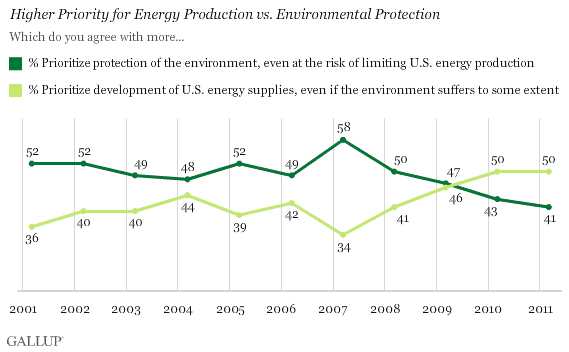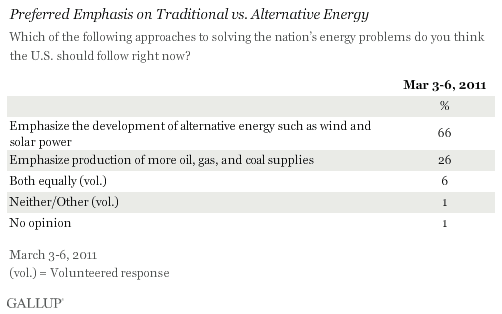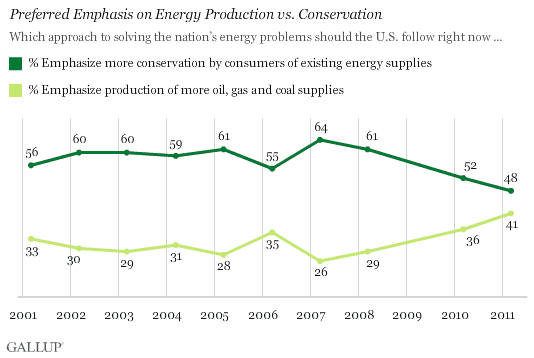PRINCETON, NJ -- Americans, by 50% to 41%, say the nation should prioritize the development of energy supplies over protecting the environment when the two goals are at odds. This reflects the continuation of a striking reversal of attitudes compared with those seen from 2001 through 2008, when Americans showed a clear preference for environmental protection.

Americans' preference for development of U.S. energy supplies over environmental protection swelled from 34% in 2007 to 50% in March 2010 and held at that level in this year's update of Gallup's annual Environment survey, conducted March 3-6.
A separate update of the question in May 2010 -- a month after the explosion that triggered the British Petroleum oil spill in the Gulf of Mexico -- found a significant uptick in Americans' choosing the environment over production. However, that proved a short-lived reaction to the event.
Development of Alternative Energy Has Broad Appeal
While Americans have grown more likely since 2007 to value U.S. production of fossil fuels as a national priority, they nevertheless see developing alternative energy sources as even more important. This is according to a new question included on the 2011 Environment poll that finds 66% of Americans choosing "development of alternative energy such as wind and solar power" as the preferred approach for addressing energy concerns, while 26% choose "production of more oil, gas, and coal supplies."

Preference for Conservation Over Production Narrows
Additionally, the annual Environment poll asks Americans whether increased production of fossil fuels or increased energy conservation is the better approach to solving the United States' energy problems. Americans' once-lopsided preference for conservation has narrowed considerably in recent years, from 64%-26% in 2007 to 48%-41% today.

Bottom Line
Americans' willingness to put environmental interests over U.S. energy needs has waned over the past four years -- perhaps a reflection of their underlying concerns about the economy. As in 2010, more Americans today believe energy production should have priority over environmental protection. And a record-high 41% now think the U.S. should emphasize production of fossil fuels as the preferred solution to the nation's energy problems, although a 48% plurality continues to favor conservation. The same poll showed increased public support for offshore oil drilling and oil exploration in Alaska.
The poll findings come at a time when U.S. energy policy may be at a crossroads, with gas prices once again exceeding $3.50 a gallon and Republicans putting pressure on President Barack Obama to back increased oil production and exploration. Obama's preferred emphasis on a new generation of nuclear power plants in his "clean energy" plan may be undermined by the unfolding crisis resulting from the catastrophic earthquake in Japan. While continued higher gas prices would likely encourage consumers to conserve more gas, they could conceivably cripple an already weak economy and do serious damage to Obama's job approval ratings.
As the administration weighs its options, one policy Obama could champion without fear of much public resistance is developing alternative energy sources such as solar and wind power. From the high level of support Americans show for that option, it appears that it simultaneously satisfies their demand for energy and addresses their concerns about energy independence, while being sensitive to environmental concerns.
Survey Methods
Results for this Gallup poll are based on telephone interviews conducted March 3-6, 2011, with a random sample of 1,021 adults, aged 18 and older, living in the continental U.S., selected using random-digit-dial sampling.
For results based on the total sample of national adults, one can say with 95% confidence that the maximum margin of sampling error is ±4 percentage points.
Interviews are conducted with respondents on landline telephones (for respondents with a landline telephone) and cellular phones (for respondents who are cell phone-only). Each sample includes a minimum quota of 150 cell phone-only respondents and 850 landline respondents, with additional minimum quotas among landline respondents for gender within region. Landline respondents are chosen at random within each household on the basis of which member had the most recent birthday.
Samples are weighted by gender, age, race, education, region, and phone lines. Demographic weighting targets are based on the March 2010 Current Population Survey figures for the aged 18 and older non-institutionalized population living in continental U.S. telephone households. All reported margins of sampling error include the computed design effects for weighting and sample design.
In addition to sampling error, question wording and practical difficulties in conducting surveys can introduce error or bias into the findings of public opinion polls.
View methodology, full question results, and trend data.
For more details on Gallup's polling methodology, visit www.gallup.com.
